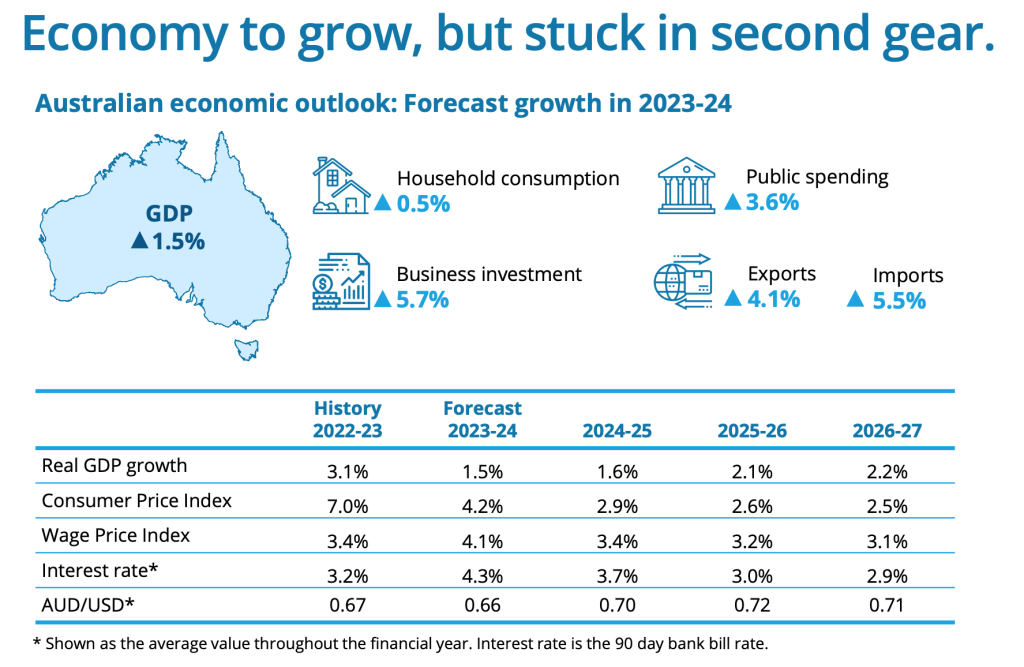‘Feel like a recession’: Economist forecasts years of financial pain as inflation and rates bite

Australia is unlikely to fall into recession in 2024 but for most families it will feel like one, according to a leading economist who’s predicting years of financial pain for households.
Analysis published on Tuesday by Deloitte Access Economics (DAE) predicted the Australian economy will slow markedly this year as the effects of the Reserve Bank’s interest rate hikes hit home.
The good news is that inflation, having peaked last year, will continue easing throughout 2024.
But that’s cold comfort for many families, according to DAE partner Stephen Smith, who says real household disposable income has fallen almost 9 per cent from its COVID-19 peaks.
Smith is predicting “at least” five years of financial pain on the horizon, with disposable income set to be below the trend seen between 2008 and 2019, delivering “pretty tough” conditions.
“The Bureau of Meteorology measures both the ambient temperature and the apparent (or ‘feels like’) temperature,” he said.
“That may be a useful means of thinking about the Australian economy over the near term, too – the economy will be growing, but it will ‘feel like’ a recession.”
Here are four takeaways from the report.
Growth slowing
Smith predicts Australia’s annual economic growth has dipped below two per cent for the first time in three years as the effects of high inflation and the rate hikes designed to curb it hit home.
Gross Domestic Product (GDP) is set to rise 1.5 per cent for 2023-24 and 1.6 per cent in 2024-25, according to the DAE forecasts.
That’s far from a recession, but on a per-capita (population adjusted) basis Australia has been experiencing a downturn for some time, helping explain why households are feeling the pinch.
Household savings as a ratio of disposable income, for example, will fall from 4.3 per cent in 2022-23 to just 1.1 per cent in 2023-24.

Source: Deloitte Access Economics (click to enlarge).
Inflation easing
Thankfully, the major pressures that have delivered the cost-of-living crisis in recent years are now abating in large part, with headline inflation set to continue falling throughout 2024.
That should mean a peak for interest rates is on the horizon too, with price data for the December quarter due for release on Wednesday set to prove crucial for the RBA’s first meeting of the year in early February.
The Reserve Bank expects the annual inflation rate will fall to 4.3 per cent for the last three months of 2023 and will continue easing from there, finishing the year about 3.5 per cent.
But Smith wrote that there are still lingering upside risks for Australia’s inflation outlook.
“The key areas of concern for the inflation outlook remain concentrated in services and predominantly reflect supply constraints in housing and utilities that will take time to unwind,” he said.
“Consequently, these two areas have become the subject of significant policy focus by all levels of government.”
Strong jobs market to soften
Last year was historic for Australia’s jobs market, with employment gains racing ahead of expectations and the jobless rate remaining near an historic low heading into the new year.
But while a sharp uptick in unemployment is unlikely in 2024, there are expectations that the jobs market will soften as the effects of higher interest rates constrain demand nationwide.
Smith said that one of the first areas that weakness has shown up is underemployment, which has risen 0.7 percentage points since February last year, with 12.5 million hours per month of work that Australians would be willing to do but aren’t currently doing.
“Alongside slowing employment growth, the unemployment rate is expected to gradually increase to 4.5 per cent by the end of the 2024 calendar year,” Smith said.
Wages to rise
The silver lining for Australian workers is that wages growth is set to finally start outpacing inflation in 2024, with the Wage Price Index set to have finished 2023 at 4.2 per cent.
“Growth is likely to peak around this level through the first half of 2024, before cooling in line with softer labour market conditions,” Smith said.
“Importantly, wage growth is expected to outpace headline inflation in each quarter of 2024, meaning that Australian workers will continue to see a partial reversal of the decline in real wages felt since the onset of the pandemic.”








